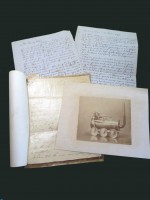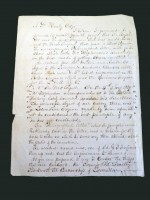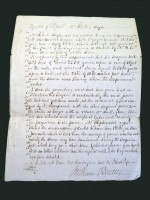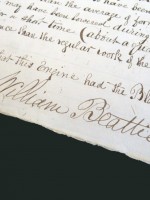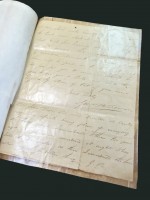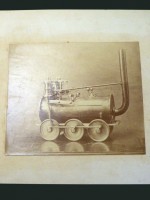RAILWAYANA original 1870s handwritten letter concerning George Stephenson
Disputing Stephenson's claim to have invented the Locomotive
Author
Publisher
Printing Details
This an original letter, undated but probably 1870s, from William Beattie to George Healey, which appears to dispute George Stephenson's claim to have invented the Locomotive.
The handwritten letter consists one sheet of handwriting as communication to Mr Healey, one sheet of handwritten copy of a report by a Mr Walker on Timothy Hackworth's Royal George, a three page early photograph of a letter from George Stephenson to Timothy Hackworth (which had been enclosed with the original letter), and an early photograph of the Royal George (or a model of the Royal George).
This is the text of the letters:
To Geo Healy Esqre
I believe I promised (if possible you) with proofs that the Royal Geo. [George] was the first Engine that beat an old horse, and the First Engine that had a blast pipe in. The accompanying Photographed letter will go to show what were Geo. Stephenson's knowledge on the best mode of getting steam in 1828.
An extract from Mr Walker and Rastrick's Report to the Liverpool and Manchester Directors will show what were G S's (George Stephenson's) latest improvement in the Bolton Engine which was the specimen engine for the L & M Ry Co:
“Mr Walker's Report. On the 15th of Jany 1829, Mr Stephenson accompanied us to the Bolton Railway lately executed under his direction. The principle object of our survey: There was a Locomotive Engine made by him upon what he considered the best principle if any he has yet constructed.”
See photographed letter what the principles were. The Dandy Cart in the letter was a vehicle for the horse to ride in which he seems very thin skinned about the credit of the invention.
The accident named was, one of old G.S. Engines blew up and sent the engineman to shivers.
As you are prepared to give to Caesar the things that are Caesar's. We claim for old Timothy Hackworth the Caesarship of Locomotion.
Page 20 of the Report, Mr Walker says:
“Mr Robert Stephenson has reported to us an experiment with Hackworth's Engine, which I prefer because that Engine has a safety valve, which although not quite out of the power of the engineman is stated by Mr S to have been at liberty at the time.
It appears by this experiment that the Engine took 48½ tons of Goods 2500 yards, upon a rise of 10 feet in the mile, and returned down equal to 5000 yards upon a level, at the rate of 11 2/10 miles per hour, and the steam was blowing when the experiment ended.
I state the preceding as it has been given to us – Hackworth's Engine is the most power full that has yet been made, as the amount of tons conveyed by it compared with the other Engines proves:- The Boiler is longer with a return or double flue; there are six wheels and the weight is increased nearly in proportion to the power. Mr Stephenson's report states the consumption of coals to have been 1 6.10 lbs per ton per mile which is less than the average of former results and probably the steam may have been lowered during the experiment, which being for a short time (about a quarter of an hour). It is no better evidence than the regular work of the Engine which has been detailed”.
RS did not know that this Engine had the Blast Pipe in 1827.
[signed] William Beattie.
Photographed Letter
Addressed to Timothy Hackworth, Engineer, New Sheldon, Darlington.
Liverpool 25th July 1828
Dear Timothy
Brandreth has given a report here that you are going to lay off the locomotive engines, is it so? It was a great pity that the accident took place with the pipes. It appears Brandreth has got [?some] plan introduced for the horse to ride which I suppose he will set off as his own invention. It is more than two years since I explained this to Brandreth – Canterbury was the place where I meant to have put it to use, but as that company have now determined to work the line by steam power it will not be wanted.
We have tried the new locomotive engine at Bolton, which works beautifully there is is not the least noise about it, we have also tried the blast to it for burning coal and I believe it will answer – there are five bellows worked by eccentrics, underneath the tinder. The line will be opened on the 1st August. It is too far for you to come, or I should be glad to see you. Write me about the engines by return of post if you can.
Your truly
George Stephenson
PS John Dixon and every Director at Canterbury can speak to my plan of carrying the horses which I mentioned to them two years ago, but I never considered it ought to be held at Darlington as there I considered the Locomotion Engines a better thing – G.S.
William Beattie. 1836–1882, (an engine designer and part of a railway engineering family) is claiming (as far as I can tell) that Hackworth's Royal George had a blastpipe, whereas Stephenson didn't start incorporating one until 1830. The recipient, George Healey, was a successful silk merchant and trader, and one of the Rochdale Pioneers (in full the Rochdale Society of Equitable Pioneers.
Condition
The handwritten letter is in good readable condition, with some small tears to the edges and a little bit of ink smudging. The photographed Stephenson letter is in good condition considering what it is, as is the mounted photograph.
Sold
